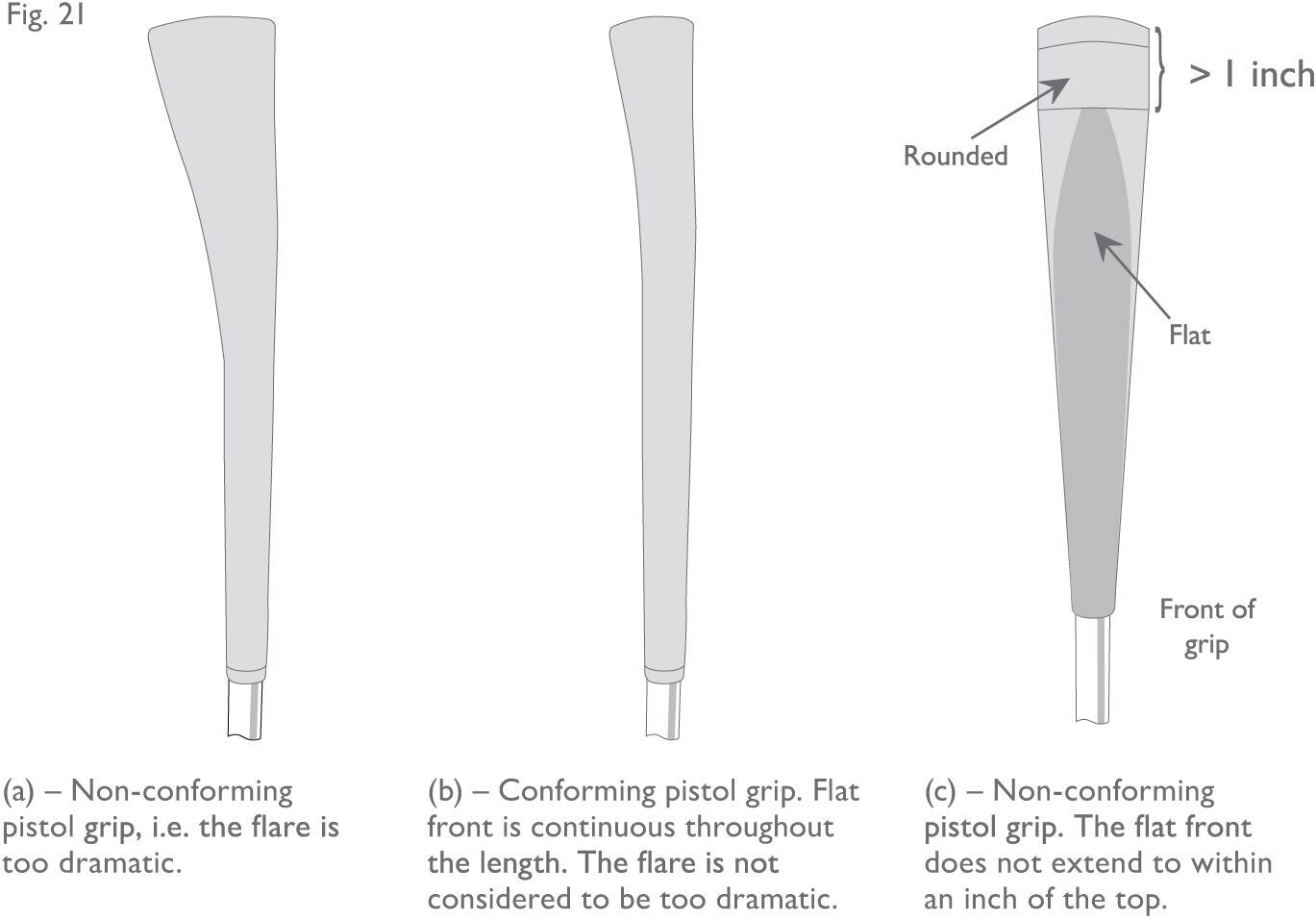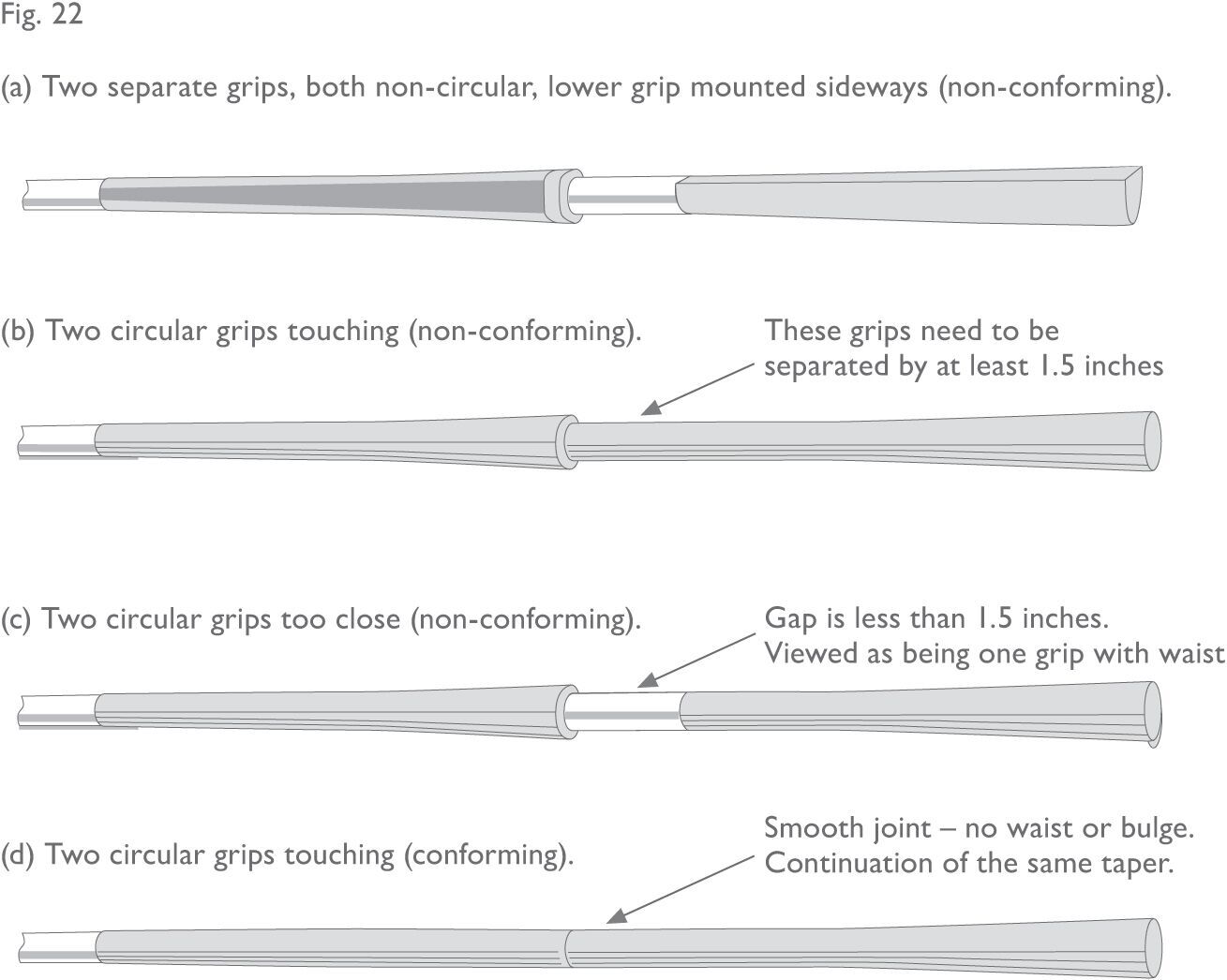Interpretation of Rule 3.a
The grip is primarily for the purpose of assisting the player in obtaining a firm
hold – so that the club does not slip or twist out of the player’s hands. However,
the installation of a grip onto the shaft is optional.
When no material is added to the part of the shaft designed to be held by the player,
the provisions relating to the grip take precedence over the provisions relating to
the shaft. Therefore, the dimensions and crosssection of that area of the shaft could
change (per Section 3b) and equal bending in any direction would not be required (so
Section 2b does not apply in this case).
In order to accommodate both hands, the grip must be at least 7 inches (177.8 mm)
in length. This also applies to clubs which have been designed to be used one-handed.
For putters which have two grips, see Section 3c below.
Due to the nature of grips and the grip provisions, it is sometimes challenging to
make a ruling without examining and comparing examples of other grips which are known
to either conform or not conform. However, this is not something which would normally
be possible in the field. It may help to remember that the overall consideration is
that a grip “must not be moulded for any part of the hands”. If a certain feature
on the grip enables the player to place his or her hands in exactly the same position
every time, solely by feel, then it must be determined whether that feature renders
the grip “moulded for the hands”. An extreme example of a grip which would be ruled
“moulded for the hands” is the type of training grip often used to help beginners.
However, a grip which has subtle changes in surface texture would usually be considered
conforming. Likewise, printed markings which assist with the correct placement of
the hands visually would normally be considered conforming. Most of the details contained
in Sections 3b and 3c below serve to clarify and expand on this basic principle.
Interpretation of Rule 3.b
3.b(1) - Circular Cross-section for Woods and Irons
Grips on woods and iron clubs are allowed to deviate from circular by having a slightly
raised rib running along the full length of the grip (often called a “reminder rib”).
“Slightly raised” is interpreted to mean that the maximum and minimum diameters of
the cross-section at any point must not differ by more than 0.040 inches (1.016 mm).
While this measurement can be taken using a pair of callipers, due to the nature of
gripping materials, the results of these measurements should be interpreted with caution
in the field. An additional requirement, mainly for the benefit of manufacturers,
is that the dimension of the rib width, from edge to edge, should not exceed 50% of
the grip’s internal diameter.
In the case of a standard length grip (approximately 10 inches (254 mm) in length),
the “full length of the grip” is interpreted to mean that the rib must extend to within
3 inches (76.2 mm) of the tip (see Figure 20).

This should generally be enough to cover the span of the player’s hands on the grip.
Simulated leather wrapped grips moulded out of a rubber-like material with an indented
spiral or other similar indentations are considered to be circular in cross-section
and are permitted, as long as the fingers cannot comfortably fit in between the spirals
or indentations. Similarly, features such as lines, dots or other patterned indentations,
which are too small to fit even the smallest of fingers, would not of themselves render
a grip non-circular in cross-section. However, any feature which is considered wide
and deep enough to accommodate a finger or fingers could be ruled “moulded for the
hands” and, hence, non-conforming.
3.b(2) - Putters
As clearly stated in this clause, a putter grip may have a non‑circular cross-section,
provided that, among other things, the cross-section remains generally similar throughout
the length of the grip.
In order to accommodate the popular (and somewhat traditional) “pistol-type” putter
grips and also limit the amount of potential offset, the phrase “generally similar”
is interpreted to mean: (i) that the butt (top) end of the grip must not involve a
sharp change in slope or dramatic flare on the underside (see Figures 21(a) and (b));
(ii) that the flat front must extend to within 1 inch (25.4 mm) of the top and bottom
ends (see Figure 21(c)); and (iii) if the axis of the grip and the shaft do not coincide,
the grip must be at least 10 inches (254 mm) in length.
As with circular grips, features such as lines, dots, or other patterned indentations,
which are too small to fit even the smallest of fingers, would not of themselves render
a putter grip not “generally similar throughout the length of the grip” or “moulded
for the hands”.

3.b(3) - Cross-sectional Dimension
This clause is self explanatory, though it is important to note that the measurement
may be made in any direction on the horizontal plane, including diagonally.
3.b(4) - Axis of the Grip
This clause requires that the axis of the circular grip on an iron or wood club coincides
with the axis of the shaft. Therefore, a circular grip with the maximum diameter of
1.75 inches (44.45 mm) must not be mounted onto the shaft either off-centre or at
an angle.
Interpretation of Rule 3.c
If a putter were allowed to have two non-circular grips, it would be possible to mount
the grips such that their cross-section would not be “generally similar” throughout
the entire length (see Section 3b above). For this reason, putters which have two
grips must have two circular grips and this is interpreted strictly such that the
grips must not incorporate a reminder rib.
Where a putter has two grips, these grips are only considered separate if the gap
between them is at least 1.5 inches (38.1 mm) in length. If a smaller gap exists,
or if no gap exists, the total length from the bottom of the lower grip to the top
of the upper one would be considered “one grip”. Therefore, it is unlikely that the
grip would conform if two conventional circular grips were installed without the required
gap. Either the exposed piece of shaft between the two grips would constitute a waist,
or the point where the two grips meet in the middle would cause a bulge. If there
was no gap between the upper and lower grip, the grip could conform if the lower grip
is a continuation of the upper grip, i.e. a continuation of the same taper, and the
transition between the two sections is smooth (see Figure 22(d)).
If a putter does have two separated grips, the upper grip must be at least 5 inches
(127 mm) in length. If the grip does not satisfy this requirement, it would be considered
to be “moulded for the hands”.
Note: It is worth emphasising that it is not permissible for wood or iron clubs to
have more than one grip.



